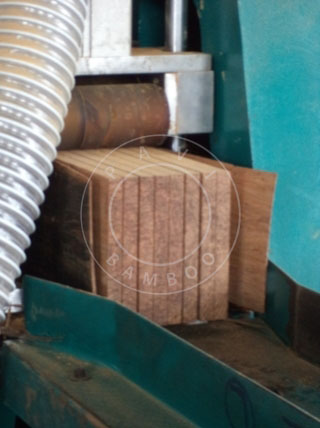×
Tempered bamboo processing phases and technology
STRAND WOVEN BAMBOO PROCESSING PHASES AND TECHNOLOGY
Tempered bamboo processing for making flooring boards (prefinished parquet with click interlocking for floating laying)
There are several stages from the bamboo stem through to the finished parquet; in brief, these are:
- cutting the culm stem which comes from the forest (just four to five year old plants, which are straight and round with a height of 15-20 metres, and which are 15-25 cm in diameter); this is then cut into logs (hollow) of the same size; the logs are cut lengthways (the culms are split) so that it can result in smooth, single crescent shaped strips (see the illustration on the right); and long square strips are then produced once the exterior nodes and green parts have been removed;
- the central part of the cane is used when it comes to making strand woven parquet flooring; the lower section is used for classic bamboo, and the top section also has thin walls, meaning it has features which are unsuitable for floors and it is used for making toothpicks and chopsticks instead;
- by this stage, the strips natural colour strips are treated in a H2O2 solution at a temperature of 85-90° C for approximately four hours; the slats on the other hand will retain a carbonised colour given they are vaporised by making them subject to two cycles of steam jet treatment; the first of which lasts for around two hours at a temperature of 140° C, while the second lasts for fifty minutes
 at a temperature of approximately 90° C; both of these processes are geared towards ridding the bamboo from all its nutrients, sugars and insects;
at a temperature of approximately 90° C; both of these processes are geared towards ridding the bamboo from all its nutrients, sugars and insects;
- thereafter the strips are conditioned and acclimatised for approximately one week which allows them to reach the correct moisture content (below 10%);
- the strips will still be allowed to rest for a few days so that they can continue to stabilise after they have been dried;
- at this stage, the strips which are intended to become strand woven bamboo are broken off and shattered for a long period; they are then
 treated with adhesive, which results in wood moisture levels of between 10 and 15%, before they are once again desiccated inside large drying machines for around one day;
treated with adhesive, which results in wood moisture levels of between 10 and 15%, before they are once again desiccated inside large drying machines for around one day;
- the slats are then selected as per their colour once they have come out of the drying machine, and are then send to be cold or hot tempered by a hydraulic presser before they are turned into rectangular bamboo blocks, which are very heavy and dense; the block is heated immediately at between 90° and 130° C and is subsequently cooled down; this process takes around half a day;
- at this point the blocks are allowed to rest in the air for as long as possible, although this should not be for longer than 14 days; after the block has been stabilised and allowed to rest, it is divided into boards using special machinery (the bamboo block is extremely hard)l the boards will continue to rest for a few days inside the drying machine so that they have the correct moisture levels; this is when the axles are
 ready for the final machining process which will transform them into flooring;
ready for the final machining process which will transform them into flooring;
- the axles can now be blasted using a sandblasting machine;
- the axles are then waterproofed at the bottom and at the sides by using German Treffert solution; this is a transitional phase which helps prevent any moisture from being absorbed on the sides of the axles and ensures that the flooring has a long service life;
- the male-female click interlocking on the four sides of the axles for floating flooring are set incredibly accurately at a rate of 330 m2 per hour using the German Homag machine tool;
- surface treatment with the American PPG finish – see safety data sheet – is the final processing stage using the Taiwanese Feng Chaou treatment system;
- the prefinished bamboo strips are packaged and dispatched after one to two days. Every stage of bamboo parquet production is interlinked by adjusting the relative humidity level of the wood in drying rooms owned by the Italian company Nardi, which allows them to reach the level of moisture required.

